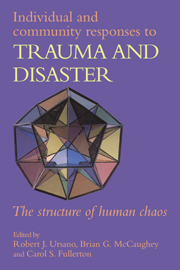Book contents
- Frontmatter
- Contents
- List of contributors
- Foreword
- Preface
- Part I Introduction
- Part II The nature of traumatic stress
- Part III The role of psychosocial context in responses to trauma and disasters
- 8 Social support and perceived control as moderators of responses to dioxin and flood exposure
- 9 Debriefing following traumatic exposure
- 10 Relocation stress following natural disasters
- 11 Group reactions to trauma: an avalanche accident
- 12 Community responses to disaster: the Gander plane crash
- Part IV Responses to trauma across the life cycle
- Part V Conclusions
- Index
9 - Debriefing following traumatic exposure
from Part III - The role of psychosocial context in responses to trauma and disasters
Published online by Cambridge University Press: 13 October 2009
- Frontmatter
- Contents
- List of contributors
- Foreword
- Preface
- Part I Introduction
- Part II The nature of traumatic stress
- Part III The role of psychosocial context in responses to trauma and disasters
- 8 Social support and perceived control as moderators of responses to dioxin and flood exposure
- 9 Debriefing following traumatic exposure
- 10 Relocation stress following natural disasters
- 11 Group reactions to trauma: an avalanche accident
- 12 Community responses to disaster: the Gander plane crash
- Part IV Responses to trauma across the life cycle
- Part V Conclusions
- Index
Summary
Soldiers are eager to talk, their memory is good, they do so better when together, in groups.
(S. L. A. Marshall Island Victory, 1944)Debriefing is a group-oriented intervention in which the major elements of a trauma are reviewed by the participants shortly after the event. Debriefing has been recommended as a stress management technique suitable for groups exposed to traumatic events, and has been practised, as such, by several rescue organizations (Dunning & Silva, 1980; Wagner, 1979; Raphael, 1986; Mitchell, 1981; Bergman & Queen, 1986; Griffin, 1987; Jones, 1985). Although intuitively helpful, the structure of this technique, its goals and its mechanisms of action have not been identified. A systematic description is needed in order for debriefing to become an object of scientific scrutiny and interest. This chapter reviews several debriefing protocols, outlines the principal dimensions of this method, and suggests a framework for future research.
Disasters, wars and traumatic events regularly result in immediate and long-term psychological changes. Among the individuals affected, behavioral and psychiatric responses range from the most pervasive forms of posttraumatic stress disorder (PTSD) to a variety of positive learning experiences.
The immediate reactions to traumatic events include all forms of human suffering and massive attempts to cope with the effects of the exposure. A wide variety of symptoms have been documented including paralyzing anxiety, cognitive disarray, dissociative and conversion reactions, psychological and physiological depletion, and emotional numbing (Bar-On et al., 1986; Weisaeth, 1989; Krystal, 1978; Green et al., 1983).
- Type
- Chapter
- Information
- Individual and Community Responses to Trauma and DisasterThe Structure of Human Chaos, pp. 201 - 219Publisher: Cambridge University PressPrint publication year: 1994
- 9
- Cited by

